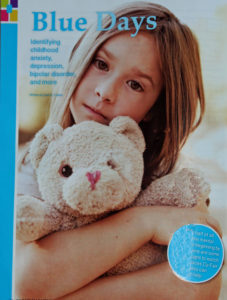 It’s a startling statistic: One in five people will suffer from a serious mental disorder at some point in their life. Anxiety, depression, bipolar disorder, and attention deficit disorder are prevalent conditions. Children probably aren’t the first age group you think of as dealing with these issues, but 4 million children and adolescents in the U.S. suffer from a serious mental disorder that causes a significant impact on their quality of life.
It’s a startling statistic: One in five people will suffer from a serious mental disorder at some point in their life. Anxiety, depression, bipolar disorder, and attention deficit disorder are prevalent conditions. Children probably aren’t the first age group you think of as dealing with these issues, but 4 million children and adolescents in the U.S. suffer from a serious mental disorder that causes a significant impact on their quality of life.
Watching for Warning Signs
With half of all lifetime cases of mental disorders beginning by age 14, according to the National Alliance on Mental Illness (NAMI), it is important to pay attention to sudden changes in your child’s behavior that could signify the onset of a disorder. AS your child’s primary caregiver and role model, parents are best suited to identify these changes and decide if it’s just a mood swing or something more.
Denise Pfister, a licensed marriage and family therapist at Cypress Family Guidance Counseling, deals regularly with the mental and emotional health of children and identifies signs a problem might be brewing. “Their academic performance may slip, they may become withdrawn socially, they may not show interest in their extra-curricular activities or they may become more emotionally volatile,” she says.
Mental and emotional disorders can quietly grow over time and seem to come out of left field, leaving many parents to ask why and wondering if it will pass or if their child needs professional help. Your child may need counseling to work through a difficult period in their development,” advises Pfister, “and if therapy is needed, counselors count on parents participating in the process. As your child’s main support system, you play a vital role in creating and managing his or her emotional and mental health.
“As is commonly suggested, these are not just signs that your child is using drugs,” Pfister says. “Just because something is wrong, doesn’t mean there is something wrong with the child. If there is a problem, a family shares it. Together, this dynamic unit can stir up unique situations as well as sort them out.
Top Concerns in Children
According to NAMI, common concerns in children include attention deficit disorder, with or without hyperactivity, which robs children of the ability to stay focused and often also includes impulsive activity. Anxiety disorders are also prevalent in children, including compulsive behaviors or phobias, which can make daily tasks seem insurmountable. Bipolar disorder, which is associated with unusual shifts in mood and energy, and depression are other concerns to look out for that can have major negative impacts on a child’s life.
Psychotherapist Nancy Eisenberg has 30 year of experience and focuses part of her Cy-Fair area practice on families. Because children are still growing, developing as a person, and learning to be part of society, mental and emotional disorders can have a greater impact on them. “Kids are more vulnerable,” Eisenberg says. “They don’t function independently, so that makes it harder. They see themselves through the eyes of adults.”
How to Treat Problems
All treatment begins with the same game plan: evaluate, strategize, and work as a team towards a solution. Both therapists like to meet with children and parents individually, and then, negotiate change together. “It’s a lot of talking and play therapy with the younger ones,” says Pfister. “We spend a lot of time building rapport with adolescents because they are very guarded.”
To parry the difficulties of sharing information discussed in therapy, Eisenberg emphasizes the value of trust towards a positive end. All areas of a child’s life overlap whether it’s home or school or outside activities. Both therapists also utilize testing to identify or aid learning problems or other situations, and if warranted, recommend medication.
Communication skill-building is a priority. Sometimes, children need help being heard and need to be assertive without being defiant. “It’s crucial to build self-esteem,” says Eisenberg. “Kids need validation, acknowledgment of their feelings, to know it’s safe and to be accepted.”
Seeking Assistance
So how does a parent get help? It is more available and affordable than most people think. Schools, doctors, community centers, and church officials can direct parents to professionals. Most insurance companies offer referrals these days, and many facilities have a sliding scale for fees, making visits more budget-friendly.
Prevention as a Family
Neuroscientists at the National Institute of Mental Health point out that the brain is designed to learn by example. Things like time management, emotions, and relational aspects create everyday moments which have a huge impact on the way the brain develops and adapts. Parents setting the example in these areas can keep children on a productive path.
One of the most important things parents can do, however, is simple: Talk to your kids on a regular basis. If parents keep communications open, beginning in elementary school and through graduation, and participate in behavior they want to see their children perform, they will gain firm footing.
Eisenberg advises, “Be supportive, problem-solve, advocate for your child, and build skills to help them cope with life.” And Pfister says, “Help them feel like they’re an integral part of the family which often comes from slowing down and just spending time together.”

